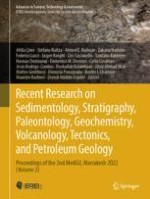2024 | Buch
Recent Research on Sedimentology, Stratigraphy, Paleontology, Geochemistry, Volcanology, Tectonics, and Petroleum Geology
Proceedings of the 2nd MedGU, Marrakesh 2022 (Volume 2)
herausgegeben von: Attila Çiner, Stefano Naitza, Ahmed E. Radwan, Zakaria Hamimi, Federico Lucci, Jasper Knight, Ciro Cucciniello, Santanu Banerjee, Hasnaa Chennaoui, Domenico M. Doronzo, Carla Candeias, Jesús Rodrigo-Comino, Roohollah Kalatehjari, Afroz Ahmad Shah, Matteo Gentilucci, Dionysia Panagoulia, Helder I. Chaminé, Maurizio Barbieri, Zeynal Abiddin Ergüler
Verlag: Springer Nature Switzerland
Buchreihe : Advances in Science, Technology & Innovation
